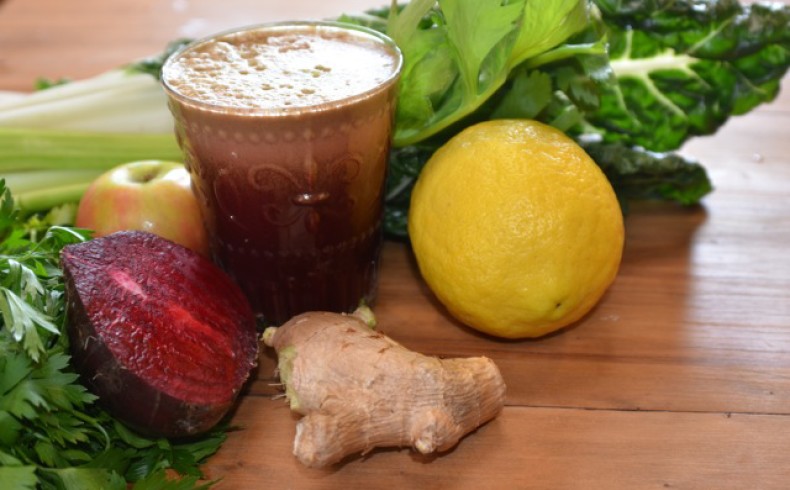
We hear so much debate about juice in the media and whether or not we should avoid or consume it as part of a healthy diet, so I hope to clear up the confusion surrounding the health benefits of juice once and for all.
Bottled Juice
In my view, commercially bottled juice really is little more than sugary water and you may as well pick up a confectionary bar or can of soft drink when it comes to the carbohydrate content of many brands, especially if it is made from fruit juice concentrate or contains added cane sugar. Let me bring this into perspective, the average 250ml serve of bottled fruit juice contains between 26 – 34gm of carbohydrate, (depending on the fruit flavour you opt for), or 10.4 – 13.6 gm per 100ml, whilst a standard 375ml can of coke contains approximately 39gms of carbohydrate or 10.4 gm per 100ml……..if you do the math, I’d say they are on par when it comes to carbohydrate content per 100ml.
Ok so whilst processed fruit juice may not be slugged with the 40mg of caffeine contained in a can of coke and may at least contain some vitamins and minerals compared to its darker cousin, it still shouldn’t get nominated for a nutrition award in my view. The reason? The manufacturing process to convert apiece of whole fruit in to juice. The juice factory takes the whole fruit, extracts the fibre – bang up goes the GI factor right there ( insulin producing factor – not good if we are trying to keep fat and inflammation to a minimum), then boils the billyo out of the juice – a process better known as pasteurisation – great for killing any nasty bacteria and enabling the juice to sit unrefrigerated on the super market shelf. But this heating process is also effective in knocking off precious vitamins and minerals in the process – so really what reason is there for drinking the stuff if it contains no fibre, no nutritional value and is on par with a can of coke in the sugar stakes per 100ml?
There are some juice brands that require refrigeration at all times because they contain no preservatives (tick), however this does not mean they escape being heated / pasteurised, they’re just removed from the heat and chilled more quickly. A little healthier than their friends on the super market shelf perhaps, but not much better in the nutrient stakes and no fruit juice can hide behind the fact that they are high in fast burning carbohydrate.
So whilst some brands of bottled juice may be a preferable choice to say soft drink and bottled juice with added sugar or those that do not require refrigeration before opening, they cannot be seen as a healthy alternative for eating a whole piece of fresh fruit when it comes to nutritional value and the impact on blood sugar levels.
The other issue surrounding bottled juice stems from the serving size. Many brands of bottled juice are just far too big, thus delivering a mega dose of fructose – the naturally occurring sugar in fruit that’s copping a bad rap from the health police right now – and rightly so considering fructose is the most fattening form of sugar we can consume. Many processed foods are laden with the stuff thanks to being a cheap sweetener as well the fact it keeps you coming back for more.
Fresh Fruit Juice
So what’s the drill on freshly squeezed fruit juice? One of the biggest misconceptions surrounding fresh fruit juice is that it is a health food. Certain mega franchise juice bars are making a killing from promoting fresh juice this way, but the truth of the matter, is that whilst the fruit may be juiced in front of you with no added sugar, concentrates or preservatives, you usually end up consuming the juice of 5 – 6 pieces of fruit or more – up to 5 times more than the recommended 1 – 2 pieces of whole fruit per day.
Take your standard Mars Bar which contains 38.4gms of carbohydrate per serve, around the same amount of carbohydrate as a 250ml serve of fresh pineapple juice. Sure the fresh pineapple juice contains nutrients such as bromelain – an enzyme renowned for its anti inflammatory action, however you should also be mindful of the pro inflammatory effects associated with excess insulin production – that results from consuming too many fast burning carbohydrates. It is the fast burning or ‘high GI’ carbohydrates that end up being the most fattening, as well as lead to the development of conditions such as obesity, diabetes, stroke and heart attack.
So whilst fresh fruit juice may contain vitamins and minerals that confectionary or soft drink lacks, we really should be limiting our juice intake to a small serve (200 – 250ml) of freshly squeezed fruit juice, consumed as an occasional treat – say once a fortnight or less – especially if you are trying to lose fat. Better still, try to choose low to medium GI – (glyceamic index – a measurement of the insulin producing factor for various foods), fruits in your fresh fruit juice combo.
Here’s a breakdown of the low, medium and high GI fruits below. Remember its best to pick your juice combo from the low to medium GI list :
Low GI Fruits
- Berries- blue berries, raspberries, black berries, mulberries
- Grapefruit, lemons, limes
- Avocado – yes these are classified as a fruit
- Plums
Medium GI fruits –
- Apples
- Grapes
- Strawberries
- Papaya
- Kiwi
- Peaches
- Pears
- Plums
- Apricots
- Mandarins
- Oranges – high in acid compared to lemons and grapefruit, so eat in moderation
High GI fruits –
- Banana
- Melons – watermelon, rockmelon, cantaloupe or honey dew
- Dates
- Mango
- Pineapple
- Dried fruit
But in all honesty the only healthy way to consume juice and not add extra padding to your hips and thighs, is to juice fresh organic vegetables. ‘Vegetables!’ I hear you cry…… well all I can say is try it! You may be pleasantly surprised, not to mention your skin will start to glow and your hair glisten. Vegetable juicing has long be renowned for its ability, not only to provide your body with a giant wack of vitamins and minerals, but as one of the most effective ways to alkalise your body overall. Put simply, if our body’s pH is more alkaline than acidic then there will be less room for inflammation and ensuing disease or illness.
To assist with easing your taste buds in to the flavour of fresh vegetable juice, I suggest adding one apple (organic of course) for a little sweetness. But as you ween yourself off a high sugar diet, your pallet will begin to change and you will no longer desire such sweet tasting food. In fact you may even notice that your food begins takes on a whole new flavour ( for the better), as your system begins to alkalise and recalibrate so to speak.
The best fruits and vegetables I recommend for juicing are:
Essentially any green vegetable that will give you a decent amount of juice. Vegetables are also HIGHLY alkalising and great to assist in detoxing and stimulating your bowel function:
- Celery
- Cucumber
- Spinach or silver beet
- Lemons or limes – these are LOW in fructose and add a lovely tang to your juice and are naturally alkalising to your system as well as great for stimulating liver detoxification and bile production for fat emulsification (digestion)
- Grapefruit
- Beetroot – remembering though these are higher in carbohydrate when juiced than greens, so limit your serve to a medium size beetroot max.
- Carrot – I tend to avoid juicing carrots because the GI (insulin producing) factor increases dramatically compared to eating them whole, so although a rich source of beta carotene, consume them raw or blanched and include protein such as fish chicken or meat, to reduce the GI factor
- Aloe vera – has a soothing, anti inflammatory effect on the lining of the intestine – great for those suffering IBS – irritable bowel syndrome – add a slurp of bottled aloe if you can’t source it fresh.
- Ginger – contains natural anti-flammatory properties as well as being grounding to the nervous system
- Tumeric – an even more powerful anti-flammatory agent, as well as a whole host of healing properties
- Parsley
- Lettuce or bok choy
Of course you don’t have to include all these vegetables in your fresh juice, but including at least 4 varieties is a good start.
My personal recommended combination:
- 1 medium sized beetroot
- 4 sticks of celery
- 1 cucumber
- 1 lemon
- 1 small to medium apple
- 1 – 2 spinach or silver beet leaves
- Small knob of ginger and or turmeric
Of course I only recommend juicing organic vegetables
I recommend avoiding these vegetables if you have or suspect you may suffer from an underactive thyroid as belonging to a family with a rather odd name – the cruciferous family – they can block the absorption of minerals such as iodine from the thyroid gland – an essential mineral necessary to produce thyroid hormones.
- Kale
- Cabbage
- Broccoli
- Collards
Be sure to drink your freshly made juice immediately if you using a traditional (centrifugal) juicer, as it will quickly oxidise from free radical damage and avoid making it in bulk to store in the refrigerator for later consumption.
I also recommend washing down your fresh vege juice with a large glass of filtered water as vegetable juice combinations are quite rich and may irritate your bowel if you drink too much in one hit.
So just to recap – when it comes to juice – my top recommendation is fresh organic vegetable juice with no more than 1 apple.
Fresh fruit juice is fine as an occasional treat versus a daily staple. Try to limit fruit juice to a 200ml serve, made from low to medium GI fruits if possible.


Health & Lifestyle Tips
Delicious Healthy Recipes
Educational & Recipe Videos









That’s great to hear Jodi, It’s my favourite combination I’ve tweaked over the years of juicing. I used to add beetroot, but found it was a little rich for my stomach. I actually crave the Green Goddess combo each morning now and really notice a difference if I dont start my day with it – you could call it a healthy addiction!
That’s great to hear Jodi, It’s my favourite combination I’ve tweaked over the years of juicing. I used to add beetroot, but found it was a little rich for my stomach. I actually crave the Green Goddess combo each morning now and really notice a difference if I dont start my day with it – you could call it a healthy addiction!
Just made your recomended combination -Vegetable Juice. Yum it tastes delicious. I have been trying a few Veggie Juice combos but havent found one that tastes nice like this one. Im new to the Vegetable Juicing so willing to try any delicous combinations. 🙂
Just made your recomended combination -Vegetable Juice. Yum it tastes delicious. I have been trying a few Veggie Juice combos but havent found one that tastes nice like this one. Im new to the Vegetable Juicing so willing to try any delicous combinations. 🙂
I like this post, enjoyed this one thankyou for putting up.
I like this post, enjoyed this one thankyou for putting up.
Some genuinely quality articles on this site, saved to fav.
Some genuinely quality articles on this site, saved to fav.
My partner and i still cannot quite believe that I could become one of those studying the important recommendations found on your site. My family and I are sincerely thankful for your generosity and for providing me the opportunity to pursue my chosen career path. Thanks for the important information I managed to get from your web site.
My partner and i still cannot quite believe that I could become one of those studying the important recommendations found on your site. My family and I are sincerely thankful for your generosity and for providing me the opportunity to pursue my chosen career path. Thanks for the important information I managed to get from your web site.